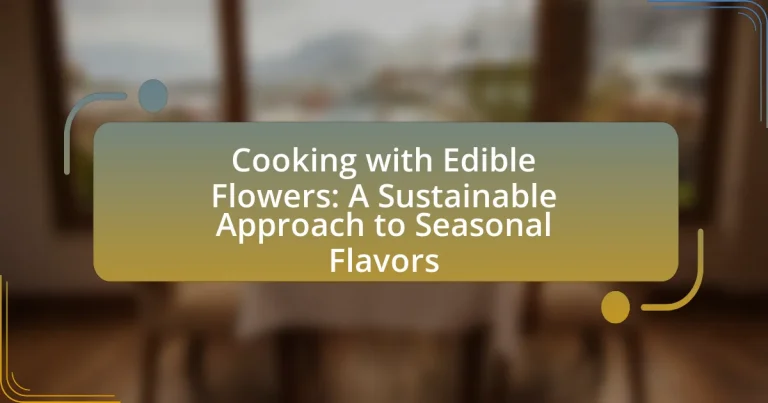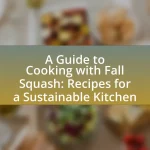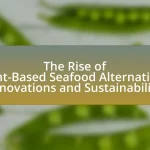Cooking with edible flowers offers a sustainable approach to enhancing seasonal flavors in culinary practices. Edible flowers, such as nasturtiums, violets, and marigolds, not only provide unique tastes and vibrant colors but also contribute nutritional benefits, including vitamins and antioxidants. The article explores how these flowers can elevate the presentation of dishes, promote sustainability by encouraging local sourcing, and support biodiversity through diverse plant cultivation. Additionally, it outlines best practices for incorporating edible flowers into cooking, including safe preparation methods and creative uses in salads, desserts, and appetizers.
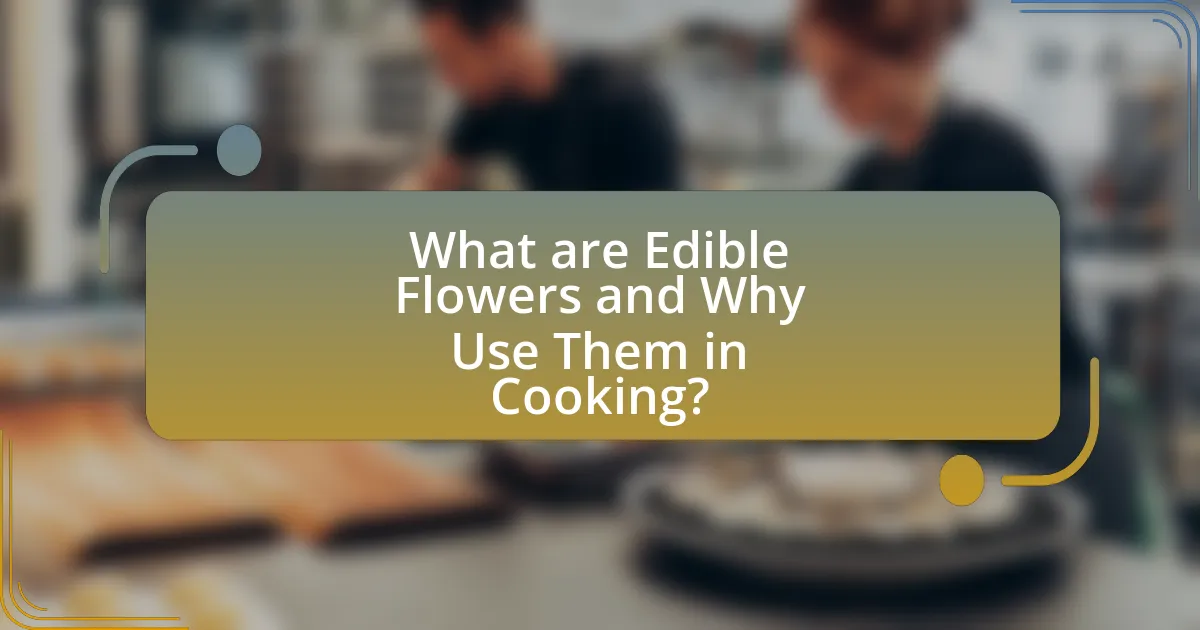
What are Edible Flowers and Why Use Them in Cooking?
Edible flowers are blossoms that are safe for human consumption and can enhance the flavor, color, and presentation of dishes. They are used in cooking to add unique tastes, such as the peppery flavor of nasturtiums or the sweet notes of violets, while also providing visual appeal and nutritional benefits. For instance, many edible flowers contain vitamins and antioxidants, contributing to a healthier diet. The use of edible flowers in culinary practices dates back to ancient civilizations, where they were incorporated into various dishes for both flavor and medicinal purposes.
How do edible flowers enhance culinary experiences?
Edible flowers enhance culinary experiences by adding unique flavors, vibrant colors, and aromatic qualities to dishes. These flowers, such as nasturtiums, violets, and marigolds, can introduce subtle peppery, sweet, or citrus notes, enriching the overall taste profile of meals. Additionally, their visual appeal elevates presentation, making dishes more enticing. Research indicates that incorporating edible flowers can also promote sustainability by utilizing seasonal ingredients, aligning with modern culinary trends that prioritize local and organic sourcing. This approach not only enhances flavor and aesthetics but also supports environmental sustainability in food practices.
What flavors and aromas do different edible flowers provide?
Different edible flowers provide a variety of flavors and aromas that enhance culinary dishes. For instance, nasturtiums have a peppery flavor reminiscent of arugula, while violets offer a sweet, floral taste with a hint of vanilla. Lavender imparts a strong, aromatic flavor that is both sweet and slightly herbaceous, making it popular in desserts and teas. Marigolds, particularly the French variety, contribute a citrusy flavor, often compared to saffron, and can add a vibrant color to dishes. Additionally, chamomile flowers provide a mild, apple-like flavor, which is soothing in teas and desserts. These distinct flavors and aromas not only elevate the taste of food but also add visual appeal, making edible flowers a versatile ingredient in cooking.
How can edible flowers be used to elevate presentation in dishes?
Edible flowers can elevate presentation in dishes by adding vibrant colors, unique shapes, and visual interest. Their diverse hues, such as the bright yellows of nasturtiums or the deep purples of violets, enhance the aesthetic appeal of plates, making them more inviting. Additionally, the intricate forms of flowers can create focal points in a dish, drawing attention and enhancing the overall dining experience. Studies have shown that visually appealing food can increase appetite and enjoyment, supporting the idea that presentation plays a crucial role in culinary experiences.
What are the nutritional benefits of incorporating edible flowers?
Incorporating edible flowers into the diet provides various nutritional benefits, including vitamins, minerals, and antioxidants. For instance, flowers like nasturtiums are rich in vitamin C, which supports immune function, while calendula contains flavonoids that have anti-inflammatory properties. Additionally, many edible flowers, such as hibiscus, are known for their high antioxidant content, which can help combat oxidative stress in the body. Research has shown that the consumption of edible flowers can enhance overall dietary diversity, contributing to better health outcomes.
Which vitamins and minerals are commonly found in edible flowers?
Edible flowers commonly contain vitamins A, C, and K, as well as minerals such as calcium, potassium, and magnesium. For instance, nasturtiums are rich in vitamin C, while dandelion flowers provide a good source of vitamins A and K. Additionally, many edible flowers, like hibiscus, are known for their high antioxidant content, which contributes to overall health benefits.
How do edible flowers contribute to a balanced diet?
Edible flowers contribute to a balanced diet by providing essential nutrients, antioxidants, and unique flavors that enhance the overall nutritional profile of meals. For instance, flowers like nasturtiums are rich in vitamin C and have antimicrobial properties, while calendula contains carotenoids that support eye health. Additionally, edible flowers can add variety and visual appeal to dishes, encouraging the consumption of a wider range of fruits and vegetables, which is crucial for a balanced diet. Studies have shown that incorporating diverse plant-based foods, including edible flowers, can improve dietary quality and promote health benefits such as reduced inflammation and improved digestion.
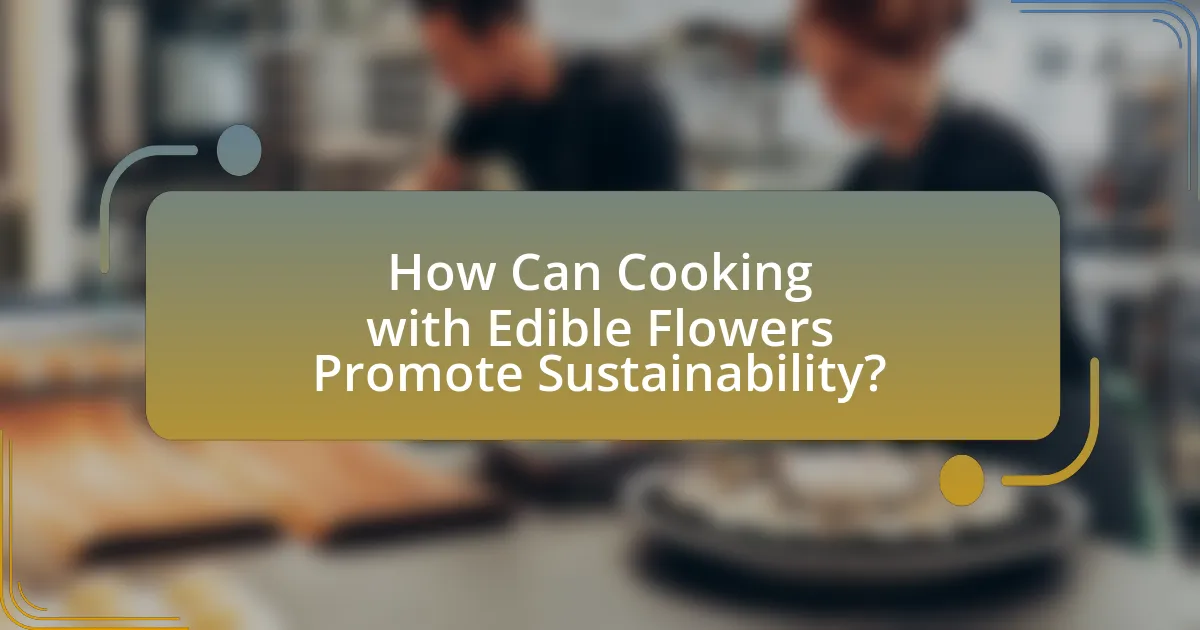
How Can Cooking with Edible Flowers Promote Sustainability?
Cooking with edible flowers promotes sustainability by encouraging the use of locally sourced, seasonal ingredients. Utilizing edible flowers reduces the carbon footprint associated with transporting food over long distances, as many flowers can be grown in home gardens or sourced from local farms. Additionally, edible flowers often require fewer resources, such as water and fertilizers, compared to traditional crops, thus minimizing environmental impact. Research indicates that incorporating diverse plant species, including edible flowers, can enhance biodiversity and soil health, further supporting sustainable agricultural practices.
What role do edible flowers play in seasonal cooking?
Edible flowers enhance seasonal cooking by providing unique flavors, colors, and textures that complement fresh, local ingredients. These flowers, such as nasturtiums, violets, and calendula, are often harvested at their peak, aligning with the seasonal availability of produce. Their incorporation into dishes not only elevates visual appeal but also introduces diverse taste profiles, enriching the overall culinary experience. For instance, nasturtiums add a peppery flavor, while violets offer a sweet, floral note. This practice supports sustainable cooking by encouraging the use of locally sourced, seasonal ingredients, thereby reducing carbon footprints associated with transportation.
How can using local edible flowers reduce carbon footprint?
Using local edible flowers can significantly reduce carbon footprint by minimizing transportation emissions associated with food sourcing. When consumers choose flowers grown in their region, they decrease the distance food travels from farm to table, which is a major contributor to greenhouse gas emissions. For instance, food transported over long distances can generate up to 11 times more carbon emissions compared to locally sourced options. Additionally, local edible flowers often require less energy for cultivation and can be grown using sustainable practices, further lowering their environmental impact.
What are the environmental benefits of growing your own edible flowers?
Growing your own edible flowers provides significant environmental benefits, including reduced carbon footprint and enhanced biodiversity. By cultivating flowers at home, individuals minimize the need for transportation associated with store-bought flowers, which often travel long distances, thus lowering greenhouse gas emissions. Additionally, homegrown edible flowers can attract beneficial insects, such as pollinators, which support local ecosystems and promote biodiversity. Research indicates that diverse plant life in gardens can improve soil health and reduce the need for chemical fertilizers, further contributing to a healthier environment.
How can cooking with edible flowers support biodiversity?
Cooking with edible flowers supports biodiversity by promoting the cultivation of diverse plant species, which enhances ecosystem resilience. When chefs and home cooks incorporate edible flowers into their dishes, they encourage farmers to grow a wider variety of plants, rather than relying solely on monocultures. This practice can lead to increased pollinator activity, as many edible flowers attract bees and other beneficial insects, which are crucial for pollination. Research indicates that diverse agricultural systems can improve soil health and reduce pest outbreaks, further supporting biodiversity. For instance, a study published in the journal “Agriculture, Ecosystems & Environment” highlights that diverse cropping systems can enhance ecosystem services, including pest control and pollination, thereby reinforcing the importance of incorporating edible flowers into culinary practices.
What types of edible flowers can be grown in home gardens?
Edible flowers that can be grown in home gardens include nasturtiums, pansies, violets, marigolds, and calendula. Nasturtiums are known for their peppery flavor and vibrant colors, making them popular in salads. Pansies and violets offer a sweet taste and are often used for garnishing desserts. Marigolds, particularly the French variety, have a citrus-like flavor and can enhance various dishes. Calendula petals are often used for their slightly spicy flavor and vibrant color in salads and soups. These flowers not only add flavor but also visual appeal to home-cooked meals.
How do edible flowers attract beneficial insects to gardens?
Edible flowers attract beneficial insects to gardens primarily through their vibrant colors and nectar-rich blooms. These visual and olfactory cues signal to pollinators and predatory insects, such as bees and ladybugs, that a food source is available. Research indicates that flowers like nasturtiums and marigolds not only provide nectar but also serve as habitats for beneficial insects, enhancing biodiversity in the garden. Additionally, studies show that the presence of diverse flowering plants can increase the abundance of pollinators by up to 50%, thereby improving pollination rates for surrounding crops.
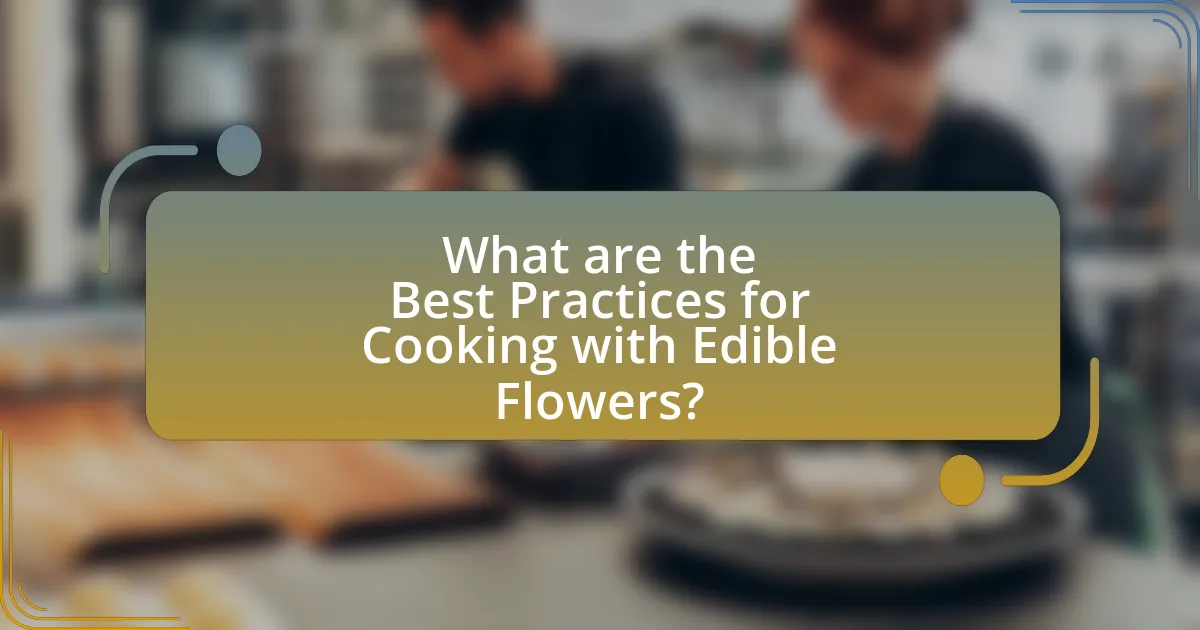
What are the Best Practices for Cooking with Edible Flowers?
The best practices for cooking with edible flowers include selecting fresh, organic flowers, ensuring they are free from pesticides, and using them in moderation to enhance dishes without overpowering flavors. Fresh flowers should be rinsed gently to remove any dirt or insects before use. Popular edible flowers like nasturtiums, pansies, and violets can be used in salads, desserts, and as garnishes, providing both visual appeal and unique flavors. It is essential to research specific flowers, as some may cause allergic reactions or be toxic. For instance, the American Society for the Prevention of Cruelty to Animals (ASPCA) provides a comprehensive list of safe edible flowers, reinforcing the importance of proper identification and usage.
How should edible flowers be prepared for cooking?
Edible flowers should be prepared for cooking by first ensuring they are clean and free from pesticides. Rinse the flowers gently under cool water to remove any dirt or insects, then pat them dry with a paper towel. Remove any inedible parts, such as stems and sepals, as they can be tough or bitter. Certain flowers, like nasturtiums and pansies, can be used whole, while others may need to be chopped or infused into oils or syrups for flavor. This preparation method is essential because it enhances the culinary experience while ensuring safety and palatability.
What cleaning methods are safe for edible flowers?
Safe cleaning methods for edible flowers include rinsing them gently under cool running water and using a soft brush to remove dirt or insects. This method effectively cleans the flowers without damaging their delicate structure. Additionally, soaking the flowers briefly in a bowl of cold water can help dislodge any remaining debris. Research indicates that these methods preserve the flowers’ integrity and flavor, making them suitable for culinary use.
How can you ensure the flowers are free from pesticides?
To ensure flowers are free from pesticides, purchase organic flowers certified by a reputable organization. Organic certification requires adherence to strict agricultural practices that prohibit synthetic pesticide use. Additionally, growing your own flowers in a controlled environment allows you to manage pest control naturally, using methods such as companion planting or organic insect repellents. Research indicates that organic farming practices can reduce pesticide residues significantly, making organic flowers a safer choice for consumption.
What are some creative ways to incorporate edible flowers into dishes?
Edible flowers can be creatively incorporated into dishes by using them as garnishes, infusing them into oils or vinegars, and adding them to salads or desserts. For instance, pansies and nasturtiums can enhance the visual appeal and flavor of salads, while lavender can be infused into honey or used in baking to impart a unique taste. Additionally, edible flowers like hibiscus can be brewed into teas or syrups, providing both flavor and color to beverages. These methods not only elevate the aesthetic of the dish but also introduce seasonal flavors, aligning with sustainable cooking practices.
How can edible flowers be used in salads and appetizers?
Edible flowers can be used in salads and appetizers to enhance visual appeal and add unique flavors. For instance, nasturtiums provide a peppery taste, while pansies offer a mild, sweet flavor. Incorporating these flowers not only elevates the dish aesthetically but also introduces diverse taste profiles, enriching the overall dining experience. Research indicates that edible flowers are rich in vitamins and antioxidants, making them a nutritious addition to meals.
What are some dessert recipes that feature edible flowers?
Dessert recipes that feature edible flowers include lavender shortbread cookies, rose petal panna cotta, and hibiscus sorbet. Lavender shortbread cookies utilize culinary lavender for a fragrant flavor, while rose petal panna cotta incorporates rose petals for a delicate floral taste and visual appeal. Hibiscus sorbet is made with dried hibiscus flowers, providing a tart and refreshing dessert option. These recipes highlight the versatility of edible flowers in enhancing both flavor and presentation in desserts.
What tips can help beginners successfully cook with edible flowers?
To successfully cook with edible flowers, beginners should start by selecting flowers that are safe for consumption, such as nasturtiums, pansies, and violets. These flowers not only add visual appeal but also enhance flavor profiles in dishes. It is essential to wash the flowers gently to remove any dirt or insects, as they are often grown without pesticides. Additionally, beginners should use flowers sparingly, as their flavors can be potent; for instance, a few petals can elevate a salad or dessert without overwhelming the dish. Finally, understanding the seasonality of edible flowers is crucial, as using fresh, in-season blooms ensures the best flavor and quality.
